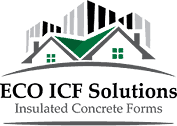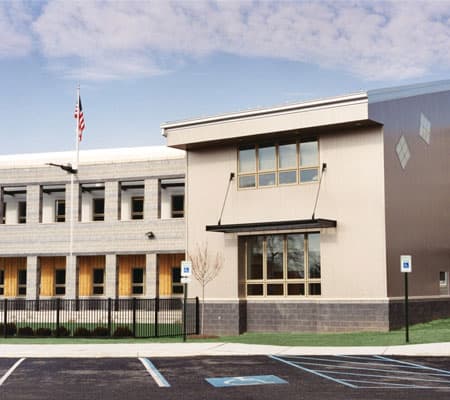Clearview Elementary School – USA
24 February 2010Hanover, Penn. – Pennsylvania’s first LEED-registered school building is helping students earn high marks while parents reap the benefits of its low utility costs.
Clearview Elementary School in Hanover, Penn., was built to compete. Now, in its first month of operation, Clearview is not your traditional wood-framed school. It was constructed with ECO-Block insulating concrete forms (ICFs). John Boecker, the lead architect on the project and founding chair of the AIA Pennsylvania Committee on the Environment, used ECO-Block as a key strategy in putting this high-performance facility to the test. His team designed Clearview to achieve U.S. Green Building Council (GBC) Leadership in Energy & Environmental Design (LEED) Certification. Clearview was also one of five buildings selected nationwide to represent the U.S. team at the 2002 GBC Sustainable Buildings Conference held last fall in Oslo, Norway.
LEED distinguishes building projects that have demonstrated a commitment to sustainable site issues, water savings, energy efficiency, materials selection and indoor environmental quality. The level of LEED certification a project receives depends on the number of credits earned for various criteria.
“From the beginning, we aimed to achieve LEED Silver Level Certification,” said Boecker, a LEED-accredited architect with L. Robert Kimball & Associates, Harrisburg, Penn. “Now it appears that we have a chance to obtain gold. We set out for Clearview to be a place where students thrive and parents and taxpayers get the most for their money, both up front and over the life of the building. ECO-Block was a powerful component for garnering these results.”
The ECO-Block ICF system is just one of the resources Boecker utilized to achieve the best possible LEED rating. Under-floor plenums for ventilation provide fresh air to keep students and teachers alert, healthy, and focused on learning. Thermal windows with daylighting strategies offer more than three times more natural illumination than conventional classrooms and help cut energy consumption in half. These strategies have also been shown to significantly augment student performance. A recent study by the California Board for Energy Efficiency showed that the learning rates for elementary students in classrooms with daylight increased 20% to 26% as measured by math and reading test scores when compared to student performance in non-daylighted classrooms.
“Since opening in December, I’ve noticed that students and staff are better at focusing on learning rather than the environment,” said Josephine Bookwalter, Clearview Elementary principal. “They’re not distracted with cold temperatures, squinting to see the board and other daily stresses. Our utility bills are benefiting, too.”
Building with ICFs has multiple advantages to owners and the environment as it consistently saves in time, money and energy resources. On the Clearview project alone, approximately 40% of the building materials were locally manufactured, reducing time and costs from having materials transported from far distances. Also, about 75% by cost were manufactured with a high-recycled content. It all adds up to an energy-efficient building projected to save $34,000 in annual energy costs.
“As a mom, it’s comforting to know that our kids have an enriching learning environment,” said Dana Yealy, Clearview PTO President. “And as a taxpayer, it’s encouraging to know that the money saved on utilities can go towards other important resources. The fact that this building saved trees is an environmental bonus.”
Concrete offers a number of benefits as a building material. In addition to being inert and non-toxic, the costs of a concrete building is comparable to one built with wood. Experienced crews report that building with ICFs can take less time than using wood-frame construction. It eliminates several steps – such as sheathing and insulating the exterior walls – that are necessary with wood-frame construction. The use of concrete also helps ensure durability.
Just as the LEED Certification and the Green Building Challenge evaluated the energy and environmental performance of Clearview, a local university will conduct student-led research in about a year to begin keeping a report card on the school’s performance.

